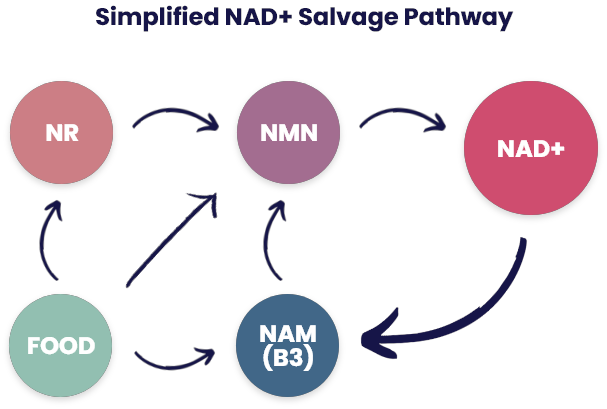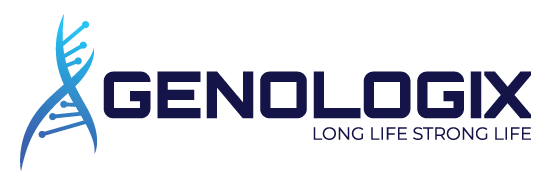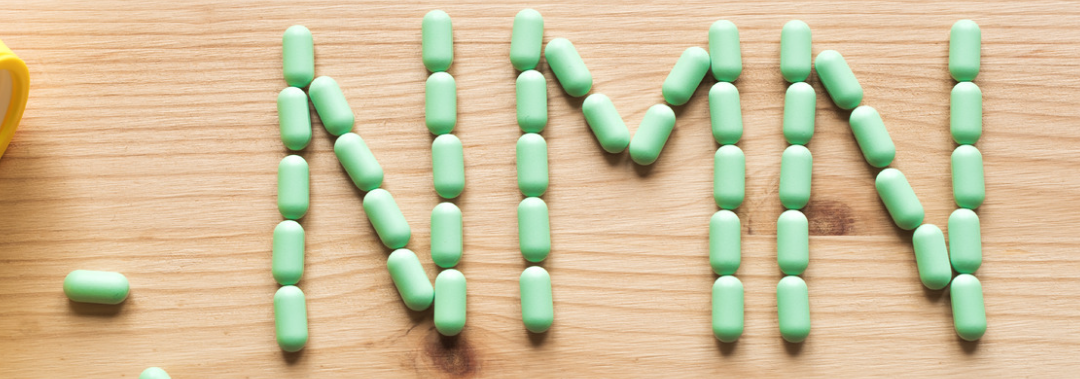Unlocking the Secret to a Longer, More Energetic Life: NMN and NAD+

What is NAD+?
NAD+ (or Nicotinamide Adenine Dinucleotide) is a molecule required for nearly all reactions in the body to take place. It’s essential for, and found in all life.
One of its key roles, is to act as an electron carrier, powering cells (more specifically their mitochondria) so that they can perform their essential functions [1]. This is fundamentally how a battery works. Electrons are moved from one end of the battery to the other and their movement creates energy that we use to power our devices.
Why Does NAD+ Decline with Age and Illness?
Circulating levels of NAD+ decline as we age. This is not to say that our NAD+ production decreases, it actually remains constant throughout our lives. Instead, a gene called CD38 activates more frequently as we age [2]. When activating, the CD38 gene consumes NAD+ and as it activates more regularly, it consumes more NAD+. This leaves less NAD+ available to other essential processes.

A set of enzymes called PARP, like CD38, also consume NAD+ [3]. PARP enzymes are responsible for repairing cellular and DNA damage (amongst many other important functions). These enzymes show increased activation in times of disease and infection. The increased PARP activity reduces the amount NAD+ available to other essential functions in the body.
What is NMN & How is It Related to NAD+?
Most of the NAD+ circulating in the body is being recycled, only a small percentage of the NAD+ produced in a given day comes from our food. A simplified NAD+ salvage (recycling) pathway can be found below.

A set of enzymes called PARP, like CD38, also consume NAD+ [3]. PARP enzymes are responsible for repairing cellular and DNA damage (amongst many other important functions). These enzymes show increased activation in times of disease and infection. The increased PARP activity reduces the amount NAD+ available to other essential functions in the body.
What is NMN & How is It Related to NAD+?
Most of the NAD+ circulating in the body is being recycled, only a small percentage of the NAD+ produced in a given day comes from our food. A simplified NAD+ salvage (recycling) pathway can be found below.
As you can see above, Nicotinamide Mononucleotide (NMN) is the final precursor to NAD+. It contains almost all of the necessary components to create NAD+ (unlike other precursors) and this has led to its popularity as an NAD+ booster.
Why Does NMN Improve Your Energy & Longevity?
AMPK (AMP-Activated Protein Kinase) is an enzyme that is required to generate ATP (Adenosine Triphosphate). ATP is the final fuel source for your mitochondria, cells, and finally you. The food you consume is converted into ATP, either from glucose (carbs/protein) or ketones (fat). Administration of NMN and the resultant increase in NAD+ levels have been shown to dramatically increase AMPK activity (and ultimately ATP production) by over 1200% in vivo [4].
The same increase in NAD+ associated with NMN supplementation results in activation of many sets of longevity genes that are involved in autophagy (removal of dead and damaged cells), healthy immune function and many other processes associated that delay the onset and even reverse the effects of aging.
Why Use NMN Over Other NAD+ Boosters?
It is possible to synthesise NAD+ and take it orally, it is however poorly absorbed in this method of administration. Intravenous (via drip) delivery of NAD+ can reliably raise NAD+ levels [5]. Despite this, the intravenous method is time consuming and discomfort is often experienced during administration.
Earlier, we mentioned that CD38 expression (activation) is responsible for lower NAD+ levels as we age. CD38 plays an important role in an effective immune response to infection [6], so ideally we don’t want to deactivate it altogether. Supplements such as Quercetin and Apigenin (in high doses) are capable of this, however the response varies in individuals based on their microbiome composition and their ability to absorb these compounds.
NMN Storage and Lifespan
NMN is most commonly produced via fermentation. Certain strains of bacteria can ferment food products to generate NMN and NR. This NMN and NR is then isolated from the fermented product. NR can be converted into NMN through another reaction (phosphorylation) to produce additional NNM. The final step is to isolate the NMN and recrystalise it into a more stable form that allows for longer periods of storage without degradation.
Initially, production methods of NMN resulted in poor product degradation times without refrigeration. Fortunately, more recent, improved production methods have resulted in more favourable degradation periods (little to almost no degradation after 6 months).
References
[1] What Is NAD+? | Why Is It Important for Health and Longevity? (2023). NMN.com. https://www.nmn.com/precursors/what-is-nad
[2] Camacho-Pereira, J., Tarragó, M. G., Chini, C. C. S., Nin, V., Escande, C., Warner, G. M., Puranik, A. S., Schoon, R. A., Reid, J. M., Galina, A., & Chini, E. N. (2016). CD38 Dictates Age-Related NAD Decline and Mitochondrial Dysfunction through an SIRT3-Dependent Mechanism. Cell metabolism, 23(6), 1127–1139. https://doi.org/10.1016/j.cmet.2016.05.006
[3] Murata, M. M., Kong, X., Moncada, E., Chen, Y., Imamura, H., Wang, P., Berns, M. W., Yokomori, K., & Digman, M. A. (2019). NAD+ consumption by PARP1 in response to DNA damage triggers metabolic shift critical for damaged cell survival. Molecular biology of the cell, 30(20), 2584–2597. https://doi.org/10.1091/mbc.E18-10-0650
[4] Kawakami S, Fukuzawa Y, Ichikawa H, Sato T, Ide T, Maeda Y, Yamamoto T. (2022) NMN “Nicotinamide Mononucleotide” Activates Intracellular Energy and Approaches the Prevention and Improvement of Aging. J Biomed Res Environ Sci. 3(5): 560-565. https://www.jelsciences.com/ articles/jbres1480.pdf
[5] Grant, R., Berg, J., Mestayer, R., Braidy, N., Bennett, J., Broom, S., & Watson, J. (2019). A Pilot Study Investigating Changes in the Human Plasma and Urine NAD+ Metabolome During a 6 Hour Intravenous Infusion of NAD. Frontiers in aging neuroscience, 11, 257. https://doi.org/10.3389/fnagi.2019.00257
[6] Glaría, E., & Valledor, A. F. (2020). Roles of CD38 in the Immune Response to Infection. Cells, 9(1), 228. https://doi.org/10.3390/cells9010228

